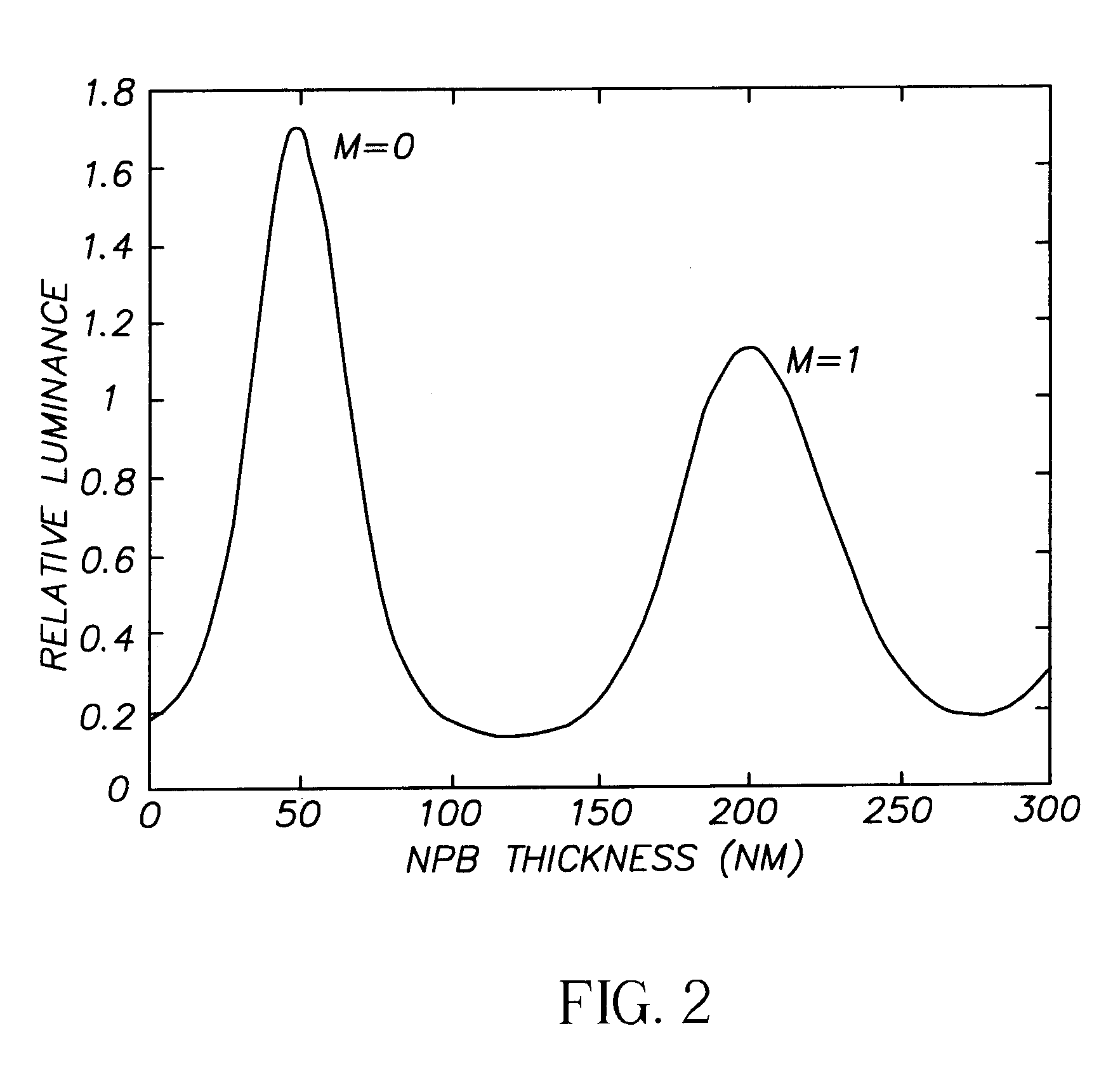Organic light emitting device having improved stability
a light-emitting diode and organic technology, applied in the direction of discharge tube luminescnet screens, instruments, natural mineral layered products, etc., can solve the problems of increasing the risk of operational degradation of the display, 80% of generated light is trapped within the device, and the small fraction of generated light available for viewing, etc., to achieve stable drive voltage, improve the stability of drive voltage, and improve the effect of top- or bottom emission efficiency
- Summary
- Abstract
- Description
- Claims
- Application Information
AI Technical Summary
Benefits of technology
Problems solved by technology
Method used
Image
Examples
example 1
[0075]A prior art top-emitting device, OLED 1A and a top-emitting device, OLED 1B of the present invention were made in the same run. The prior art device was fabricated on glass substrate having a pure Ag anode, 60 nm thick, whereas the OLED of the present invention is a bilayer anode. The bilayer anode included a 60 nm thick base layer of pure Ag and a 6 nm thick skin layer of Ag Mo alloy. The concentration of Mo in the skin layer is 20% by volume. Each of the substrates was provided with a common CFx HIL, NPB HTL, Alq EML / ETL and a semitransparent top cathode. The cathode is an alloy, MgAg, semitransparent and 14 nm thick. The concentration of Ag in the cathode layer is 10% by volume. The OLED structures were selected based on the opaque, fully reflective and single layer anode of pure Ag and optimized for maximization of top emission. The devices have the following layer structures:[0076]OLED 1 A: Glass (1.1 mm) / Ag (60 nm) / CFx (1 nm) / NPB (45 nm) / Alq (60 nm) / MgAg (14 nm)[0077]OLE...
example 2
[0080]A prior art bottom-emitting device, OLED 2A, and a bottom-emitting device, OLED 2B of the present invention were made in the same coating run. The prior art OLED was fabricated on glass substrate having a pure Ag anode, semitransparent, and 20 nm thick, whereas the OLED of the present invention is a bilayer anode. The bilayer anode is also semitransparent and included a 15 nm thick base layer of pure Ag and a 6 nm thick skin layer of AgMo alloy. The concentration of Mo in the skin layer is 20% by volume. Each of the substrates was provided with a common CFx HIL, NPB HTL, Alq EML / ETL and a fully reflective top cathode. The cathode is an alloy, MgAg, opaque and 220 nm thick. The concentration of Ag in the cathode layer is 10% by volume. The OLED structures were selected based on the semitransparent, reflective and single layer anode of pure Ag and optimized for maximization of bottom emission. The devices have the following layer structures:[0081]OLED 2 A: Glass (1.1 mm) / Ag (20 ...
example 3
[0085]A prior art bottom-emitting device, OLED 3A, and a top-emitting device, OLED 3B of the present invention were made in the same coating run. The prior art OLED was fabricated on glass substrate having a pure Ag anode, semitransparent, and 20 nm thick, whereas the OLED of the present invention is a bilayer anode. The bilayer anode of the OLED of the present invention is opaque and included a 75 nm thick base layer of pure Ag and a 10 nm thick skin layer of AgMg alloy. The concentration of Mg in the skin layer is 50% by volume. Each of the substrates was provided with a common MoOx HIL, NPB HTL and an Alq EML / ETL. The cathode for the prior device, 3A, is a fully reflective LiF / Al layer, 100 nm thick. The cathode of the device 3B is an alloy, MgAg, semitransparent and 14 nm thick. The concentration of Ag in the cathode layer is 10% by volume. The devices have the following layer structures:[0086]OLED 3 A: Glass (1.1 mm) / Ag (20 nm) / MoOx (2 nm) / NPB (200 nm) / Alq (60 nm) / LiF (0.5 nm) / ...
PUM
| Property | Measurement | Unit |
|---|---|---|
| work function | aaaaa | aaaaa |
| thickness | aaaaa | aaaaa |
| thickness | aaaaa | aaaaa |
Abstract
Description
Claims
Application Information
 Login to View More
Login to View More - R&D
- Intellectual Property
- Life Sciences
- Materials
- Tech Scout
- Unparalleled Data Quality
- Higher Quality Content
- 60% Fewer Hallucinations
Browse by: Latest US Patents, China's latest patents, Technical Efficacy Thesaurus, Application Domain, Technology Topic, Popular Technical Reports.
© 2025 PatSnap. All rights reserved.Legal|Privacy policy|Modern Slavery Act Transparency Statement|Sitemap|About US| Contact US: help@patsnap.com



